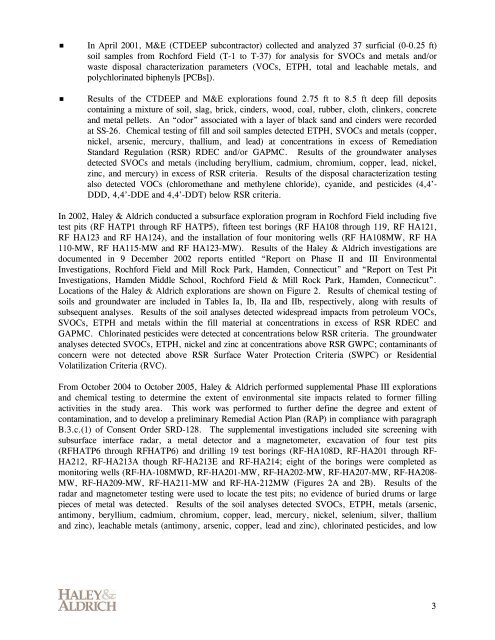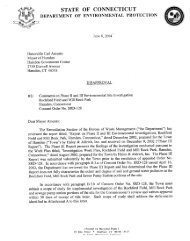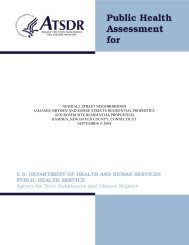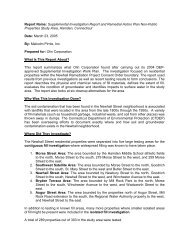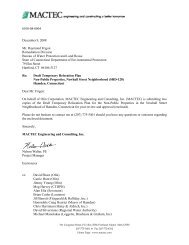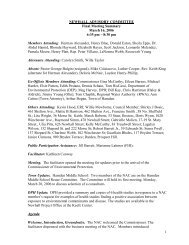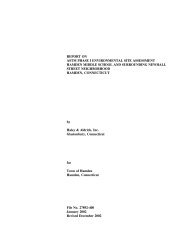Remedial Action Plan - Rochford Field - Newhall Remediation Project
Remedial Action Plan - Rochford Field - Newhall Remediation Project
Remedial Action Plan - Rochford Field - Newhall Remediation Project
Create successful ePaper yourself
Turn your PDF publications into a flip-book with our unique Google optimized e-Paper software.
In April 2001, M&E (CTDEEP subcontractor) collected and analyzed 37 surficial (0-0.25 ft)<br />
soil samples from <strong>Rochford</strong> <strong>Field</strong> (T-1 to T-37) for analysis for SVOCs and metals and/or<br />
waste disposal characterization parameters (VOCs, ETPH, total and leachable metals, and<br />
polychlorinated biphenyls [PCBs]).<br />
Results of the CTDEEP and M&E explorations found 2.75 ft to 8.5 ft deep fill deposits<br />
containing a mixture of soil, slag, brick, cinders, wood, coal, rubber, cloth, clinkers, concrete<br />
and metal pellets. An “odor” associated with a layer of black sand and cinders were recorded<br />
at SS-26. Chemical testing of fill and soil samples detected ETPH, SVOCs and metals (copper,<br />
nickel, arsenic, mercury, thallium, and lead) at concentrations in excess of <strong>Remediation</strong><br />
Standard Regulation (RSR) RDEC and/or GAPMC. Results of the groundwater analyses<br />
detected SVOCs and metals (including beryllium, cadmium, chromium, copper, lead, nickel,<br />
zinc, and mercury) in excess of RSR criteria. Results of the disposal characterization testing<br />
also detected VOCs (chloromethane and methylene chloride), cyanide, and pesticides (4,4’-<br />
DDD, 4,4’-DDE and 4,4’-DDT) below RSR criteria.<br />
In 2002, Haley & Aldrich conducted a subsurface exploration program in <strong>Rochford</strong> <strong>Field</strong> including five<br />
test pits (RF HATP1 through RF HATP5), fifteen test borings (RF HA108 through 119, RF HA121,<br />
RF HA123 and RF HA124), and the installation of four monitoring wells (RF HA108MW, RF HA<br />
110-MW, RF HA115-MW and RF HA123-MW). Results of the Haley & Aldrich investigations are<br />
documented in 9 December 2002 reports entitled “Report on Phase II and III Environmental<br />
Investigations, <strong>Rochford</strong> <strong>Field</strong> and Mill Rock Park, Hamden, Connecticut” and “Report on Test Pit<br />
Investigations, Hamden Middle School, <strong>Rochford</strong> <strong>Field</strong> & Mill Rock Park, Hamden, Connecticut”.<br />
Locations of the Haley & Aldrich explorations are shown on Figure 2. Results of chemical testing of<br />
soils and groundwater are included in Tables Ia, Ib, IIa and IIb, respectively, along with results of<br />
subsequent analyses. Results of the soil analyses detected widespread impacts from petroleum VOCs,<br />
SVOCs, ETPH and metals within the fill material at concentrations in excess of RSR RDEC and<br />
GAPMC. Chlorinated pesticides were detected at concentrations below RSR criteria. The groundwater<br />
analyses detected SVOCs, ETPH, nickel and zinc at concentrations above RSR GWPC; contaminants of<br />
concern were not detected above RSR Surface Water Protection Criteria (SWPC) or Residential<br />
Volatilization Criteria (RVC).<br />
From October 2004 to October 2005, Haley & Aldrich performed supplemental Phase III explorations<br />
and chemical testing to determine the extent of environmental site impacts related to former filling<br />
activities in the study area. This work was performed to further define the degree and extent of<br />
contamination, and to develop a preliminary <strong>Remedial</strong> <strong>Action</strong> <strong>Plan</strong> (RAP) in compliance with paragraph<br />
B.3.c.(1) of Consent Order SRD-128. The supplemental investigations included site screening with<br />
subsurface interface radar, a metal detector and a magnetometer, excavation of four test pits<br />
(RFHATP6 through RFHATP6) and drilling 19 test borings (RF-HA108D, RF-HA201 through RF-<br />
HA212, RF-HA213A though RF-HA213E and RF-HA214; eight of the borings were completed as<br />
monitoring wells (RF-HA-108MWD, RF-HA201-MW, RF-HA202-MW, RF-HA207-MW, RF-HA208-<br />
MW, RF-HA209-MW, RF-HA211-MW and RF-HA-212MW (Figures 2A and 2B). Results of the<br />
radar and magnetometer testing were used to locate the test pits; no evidence of buried drums or large<br />
pieces of metal was detected. Results of the soil analyses detected SVOCs, ETPH, metals (arsenic,<br />
antimony, beryllium, cadmium, chromium, copper, lead, mercury, nickel, selenium, silver, thallium<br />
and zinc), leachable metals (antimony, arsenic, copper, lead and zinc), chlorinated pesticides, and low<br />
3


